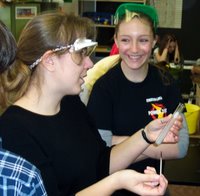Using Images in the Classroom: Copyright, Fair Use and Creative Commons
As teachers, we often claim "fair use." The Fair Use doctrine generally allows for the copying of protected material (texts, sounds, images, etc.) for a limited and “transformative” purpose, like criticizing, commenting, parodying, news reporting, teaching the copyrighted work. Under the US copyright laws, fair use “is not an infringement of copyright.” When determining Fair Use, judges typically consider four factors. Read more....
However, I am trying to teach my students to forego their typical Google Image search or pop song soundtrack and really start to think about intellectual property rights. I am no longer hiding behind the approaches: "well, we're not publishing it, so no one will notice" or "it's only a problem if you get caught."
Here is what I know so far:
Copyright - Creative work is under copyright protection the moment it is created and "fixed in a tangible form." All sorts of creative work is protected including images, songs, and written work. People do not need to register with the Copyright Office to benefit from copyright protection, but the will need to if they ever plan on bringing suit against someone for copyright infringement. If a student wants to use copyrighted material in their presentation or website, they really need to contact the creator for permission. (My students do NOT like this rule.)
Public Domain - "When a work is in the public domain, it is free for use by anyone for any purpose without restriction under copyright law. Public domain is the purest form of open/free, since no one owns owns or controls the material in any way." Mostly, this includes resources that are government work or very old. Cornell University has an updated table of copyright term and public domain rules.
Creative Commons - This is a way to modify your copyright to allow for sharing, remixing or distribution of your work. There are many "levels" of creative commons licensing. On this page, creativecommons.org lists them starting with the most accommodating license type through the most restrictive license type. Generally, the licenses address different requirements for attribution (giving the author credit), share-alike (how you will license any work you create from it), commercial use, and allowing derivative works (can you modify it).
I encourage my students to start at the following sites to find CC or public domain images:
- Google's Advanced Search (now you can filter by usage rights as of July 2009)
- Wikimedia Commons (part of Wikimedia)
- Flickr Creative Commons group
- Creative Commons search
- Podcasting Legal Guide (CreativeCommons.org)
- Duke Law has created a great comic about Public Domain and Fair Use
- Taking the Mystery Out of Copyright** (Library of Congress)
I know I have a lot left to learn, but at least I am encouraging my students to become aware of intellectual property rights and make it less likely that they will become "uninformed and unintentional plagiarists."
Labels: teaching, technology







